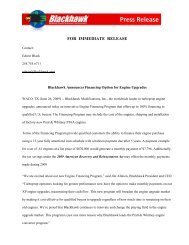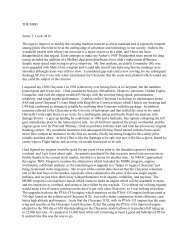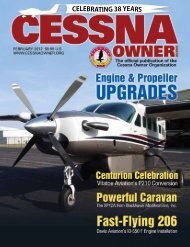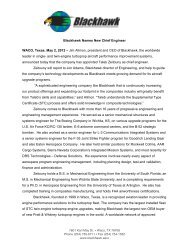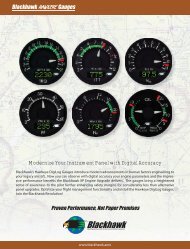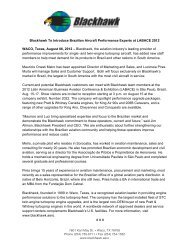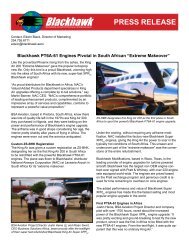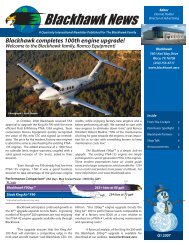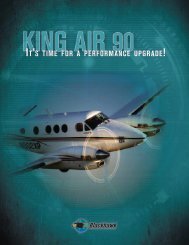Flying Blackhawk's 850 HP Caravan - Blackhawk Modifications, Inc.
Flying Blackhawk's 850 HP Caravan - Blackhawk Modifications, Inc.
Flying Blackhawk's 850 HP Caravan - Blackhawk Modifications, Inc.
You also want an ePaper? Increase the reach of your titles
YUMPU automatically turns print PDFs into web optimized ePapers that Google loves.
Going Up, Fast<br />
We climbed into the cockpit, pulled up the boarding<br />
ladders and went through the routine PT6A starting<br />
procedure; master on and fuel pump to normal, engage<br />
start switch and watch rotation begin on the Ng gauge,<br />
waiting for 15% Ng to introduce fuel. The lightoff and<br />
rise in rpm caused no more than a 750 C. indication<br />
on the ITT (start limit is 975 C). Once stabilized, we<br />
confirmed that the starter had been switched into<br />
generator mode and the avionics were flipped on.<br />
The cooperative Hartford, Connecticut tower offered<br />
to arrange for VFR flight following service as we exited<br />
their airspace to the east; Dunkin’s plan was to execute<br />
a max-performance climbout above Providence’s Class<br />
C environment. We quickly taxied to runway 21 for a<br />
prop governor test and advanced to high idle condition,<br />
extended ten degrees of flap and took the inertial<br />
separator handle out of “bypass” position. With the<br />
APE kit, extreme short-field takeoffs are approved with<br />
30 degrees of flap, versus 20 degrees for an unmodified<br />
airplane.<br />
Preferred<br />
Airparts<br />
Quarter<br />
Page<br />
4/C Ad<br />
The propeller wound up to 2000 rpm while we held<br />
the brakes, and we advanced the power lever to about<br />
2150 pounds of torque on the roll. The torque built to<br />
2200 as we lifted off at a leisurely 80 knots, halfway<br />
down the 4400-foot runway.<br />
Once past 95 knots, the flaps were brought up and I<br />
quickly accelerated the aircraft to 120 knots. Dunkin<br />
advised me to hold 115 in the climb; by doing so,<br />
visibility over the nose was nil. The VSI read 2000<br />
fpm initially, finally settling in at 1600 to 1700 fpm.<br />
<strong>Blackhawk</strong>’s brochure says the XP42A has double<br />
the climb rate of a standard <strong>Caravan</strong>, and when we<br />
compared numbers with the standard and modified<br />
charts, it appeared to be true; under similar conditions,<br />
a 675-hp 208B would manage around <strong>850</strong> fpm.<br />
With torque tweaked occasionally to keep 2200<br />
pounds pulling us upward, the ITT started out at 730<br />
degrees C. and rose to no more than 750 at the top of our<br />
climb, 11,500 MSL. Only about 8 minutes had elapsed<br />
since our sea-level liftoff. The -42A Pratt had kept its<br />
2200 pounds of torque until 10,500 feet. Temperature<br />
was about 16 degrees over standard ISA and takeoff<br />
weight was estimated at 7700 pounds.<br />
As we leveled off with 2100 pounds of torque and 750<br />
degrees on the ITT, the airspeed settled at 165 knots<br />
IAS, computing to a TAS of 202, while burning 460<br />
PPH of Jet-A. The standard 208B’s book showed that<br />
only 1370 pounds of torque would have been available<br />
at 12,000 feet, providing a TAS of about 158 knots.<br />
In all fairness, Dunkin pointed out, our TAS would<br />
have been ten knots or so less if we had been at full<br />
gross weight.<br />
Great Lakes<br />
Aero Products<br />
Quarter<br />
Page<br />
4/C Ad<br />
DECEMBER 2011 TWIN & TURBINE 21



